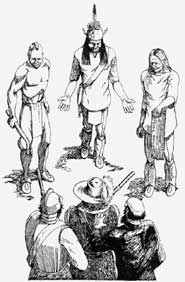|
"When the Europeans arrived, these people were governed
under one law-the Great Law of Peace," Green said.
Recently, there has been a growing awareness among scholars
that the "founding fathers" of the American government
did not derive their democratic ideals from European thinkers.
Benjamin Franklin was among the most prolific and innovative
observer of the time who tried to balance the needs of government
with a profound sense of individual liberties and human rights.
The six-nation Iroquois confederacy was cited by him as the
model for the emerging American Confederation.
The Onondagas, today located just south of Syracuse, are the
capital nation of the Iroquois Confederacy, which is made up
of Mohawks, Senecas, Oneidas, Cayugas and Tuscaroras as well.
The Iroquois Confederacy continues to be one of the oldest continuing
forms of self-government on earth.
Oren Lyons, an Onondaga chief, points out the similarity of
the three-sided Iroquois government and the three-chambered
US system. Lyons is also professor at the State University of
New York.
“The Constitution is the US government’s treaty with
its own citizens,’ according to Lyons. “the founding
fathers copied it from our government- but they forgot about
the most important part, which tells about the relationship
between human beings and the natural world.”
|

"War or Peace?" This drawing by Kahionhes
illustrates the introduction of the "Great Law
of Peace" to the Europeans - Reprinted by permission
from Cornell University's Indian Studies |
|





